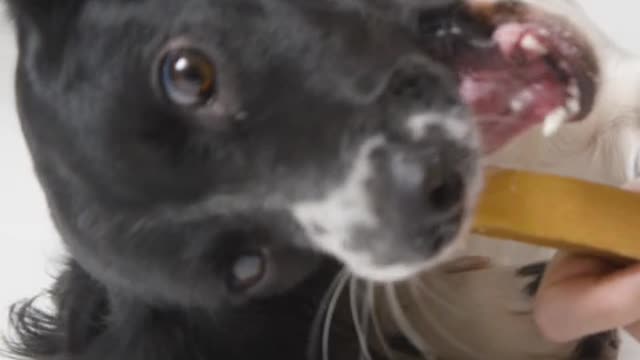Premium Only Content

The dog very hard chis eting.
The dog very hard chis eting.
In 1758, the Swedish botanist and zoologist Carl Linnaeus published in his Systema Naturae, the two-word naming of species (binomial nomenclature). Canis is the Latin word meaning "dog",[15] and under this genus, he listed the domestic dog, the wolf, and the golden jackal. He classified the domestic dog as Canis familiaris and, on the next page, classified the grey wolf as Canis lupus.[2] Linnaeus considered the dog to be a separate species from the wolf because of its upturning tail (cauda recurvata), which is not found in any other canid.[16]
In 1999, a study of mitochondrial DNA (mtDNA) indicated that the domestic dog may have originated from the grey wolf, with the dingo and New Guinea singing dog breeds having developed at a time when human communities were more isolated from each other.[17] In the third edition of Mammal Species of the World published in 2005, the mammalogist W. Christopher Wozencraft listed under the wolf Canis lupus its wild subspecies and proposed two additional subspecies, which formed the domestic dog clade: familiaris, as named by Linnaeus in 1758 and, dingo named by Meyer in 1793. Wozencraft included hallstromi (the New Guinea singing dog) as another name (junior synonym) for the dingo. Wozencraft referred to the mtDNA study as one of the guides informing his decision.[3] Mammalogists have noted the inclusion of familiaris and dingo together under the "domestic dog" clade[18] with some debating it.[19]
In 2019, a workshop hosted by the IUCN/Species Survival Commission's Canid Specialist Group considered the dingo and the New Guinea singing dog to be feral Canis familiaris and therefore did not assess them for the IUCN Red List of Threatened Species.[4]
Evolution
Main article: Evolution of the wolf

Location of a dog's carnassials; the inside of the 4th upper premolar aligns with the outside of the 1st lower molar, working like scissor blades
The Cretaceous–Paleogene extinction event occurred 65 million years ago and brought an end to the dinosaurs and the appearance of the first carnivorans.[20] The name carnivoran is given to a member of the order Carnivora. Carnivorans possess a common arrangement of teeth called carnassials, in which the first lower molar and the last upper premolar possess blade-like enamel crowns that act similar to a pair of shears for cutting meat. This dental arrangement has been modified by adaptation over the past 60 million years for diets composed of meat, for crushing vegetation, or for the loss of the carnassial function altogether as in seals, sea lions, and walruses. Today, not all carnivorans are carnivores, such as the insect-eating Aardwolf.[5]
The carnivoran ancestors of the dog-like caniforms and the cat-like feliforms began their separate evolutionary paths just after the end of the dinosaurs. The first members of the dog family Canidae appeared 40 million years ago,[21] of which only its subfamily the Caninae survives today in the form of the wolf-like and fox-like canines. Within the Caninae, the first members of genus Canis appeared six million years ago,[15] the ancestors of modern domestic dogs, wolves, coyotes, and golden jackals.
-
 LIVE
LIVE
Steven Crowder
1 hour ago🔴 Trump’s Funding Freeze: Fact-Checking the Mainstream Media Lies
38,970 watching -
 LIVE
LIVE
Graham Allen
2 hours agoThe Border Is CLOSED!! 92% Less Crossings!! + Pete Hegseth Is GOING AFTER Mark Milley!
7,202 watching -
 LIVE
LIVE
Wendy Bell Radio
5 hours agoUnapologetic
13,996 watching -
 LIVE
LIVE
Matt Kohrs
9 hours agoBUCKLE UP! IT'S FED RATE DAY!!! || The MK Show
1,323 watching -
 LIVE
LIVE
Randi Hipper
28 minutes agoBITCOIN PRICE REBOUNDS AS MORE STATES REVEAL RESERVE PLANS
154 watching -
 33:11
33:11
BonginoReport
4 hours agoYou're the Media Now (Ep.128) - 01/29/2025
24.7K68 -
 1:00:57
1:00:57
The Crypto Report
21 hours agoBREAKING CRYPTO NEWS! (PEPE, SHIB, DOGE, SUI, SOL, BTC, HBAR, XRP, CRO)
3.14K2 -
 LIVE
LIVE
Vigilant News Network
15 hours agoBill Gates Admits MISTAKE For Cozying Up to SEX OFFENDER | The Daily Dose
1,164 watching -
 LIVE
LIVE
Jeff Ahern
1 hour agoNever woke Wednesday with Jeff Ahern (The leftist Gravy train ends)
565 watching -
 18:51
18:51
Neil McCoy-Ward
2 hours agoNetflix Users May Be FORCED To Buy A TV Licence!! (This Is Getting CRAZY!)
3.81K4